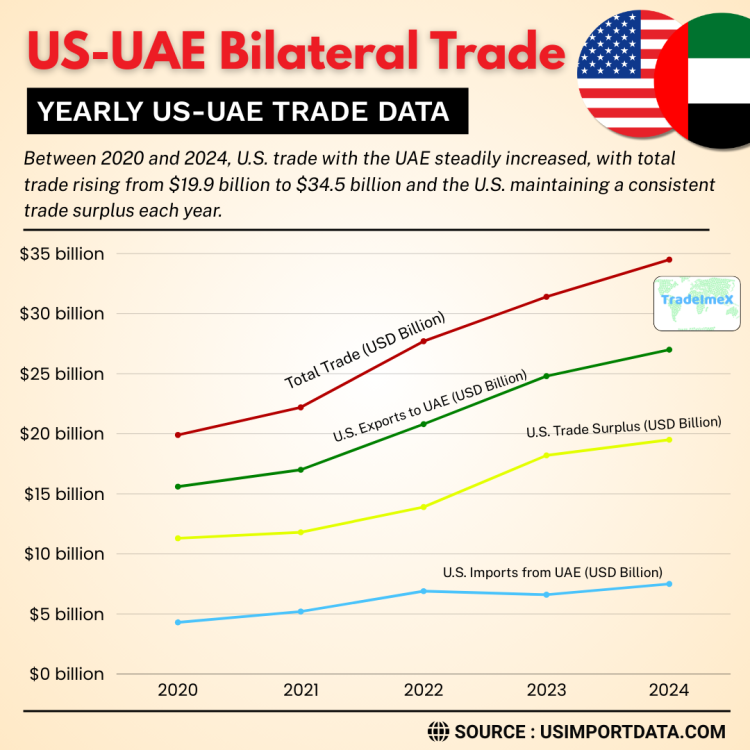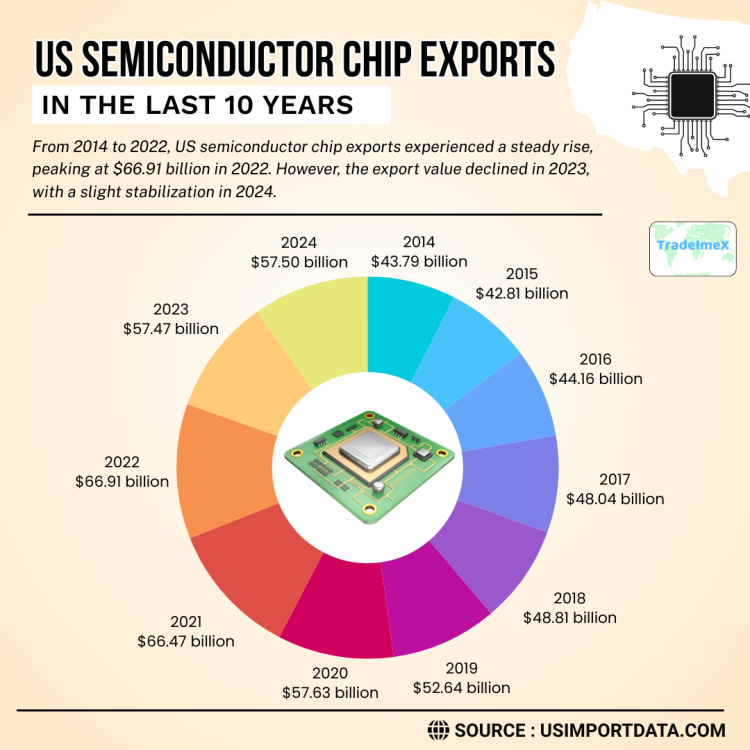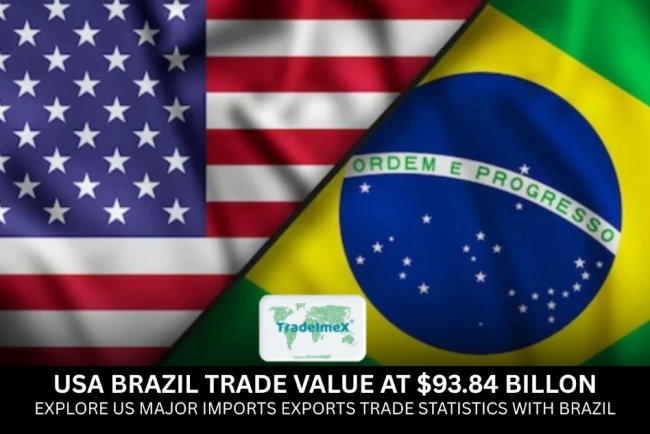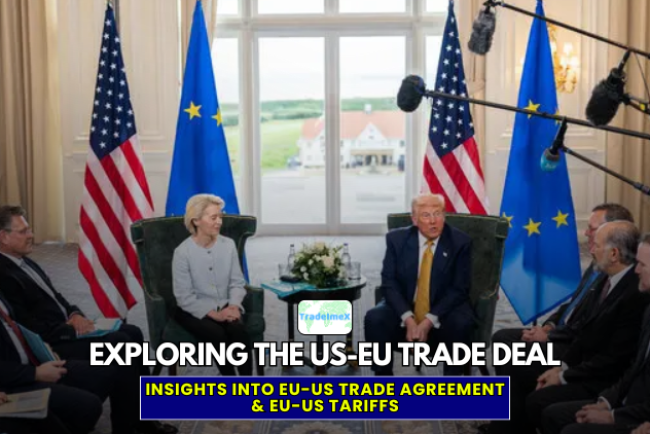US-UAE AI Chips Deal: What It Means for US Trade & Import-Export Data
Discover how the US-UAE AI chips deal is transforming international trade, boosting US semiconductor exports, and redefining tech diplomacy. Explore trade data, key exporters, and future prospects.

In recent news, the United States and the United Arab Emirates have entered into a groundbreaking deal involving the trade of AI chips. This deal has significant implications for US trade and import-export data. In May 2025, the United States and the United Arab Emirates (UAE) finalized a landmark agreement permitting the export of 500,000 advanced AI chips annually from U.S. companies to the UAE, starting in 2025. This deal signifies a strategic shift in U.S. trade policy, emphasizing technological collaboration with trusted partners and aiming to bolster economic ties and counterbalance global competitors. Based on the latest US trade data, the total value of US exports to UAE reached $26.9 billion in 2024.
According to the US export data, in 2024, semiconductor devices constituted a major global trade product, with US chip exports totaling $57.5 billion. These exports were primarily directed to Mexico, China, Malaysia, Thailand, and Germany. Let's take a closer look at what this US-UAE trade deal means and how it could impact the economic relationship between the two countries.
Understanding the US-UAE AI Chips Deal
The United States and the United Arab Emirates have inked a deal for the Gulf nation to construct the biggest artificial intelligence campus outside of the US, a type of arrangement that was previously limited due to Washington's worries about potential Chinese access to the technology.
The countries did not specify which AI chips from Nvidia (NVDA.O) or other companies might be incorporated in UAE data centers, but sources indicated that a deal would provide the Gulf country with wider access to advanced AI chips. On Thursday, Nvidia CEO Jensen Huang was captured on video talking with U.S. President Donald Trump and UAE President Sheikh Mohamed bin Zayed Al Nahyan at a residence in Abu Dhabi.
The US-UAE AI chips deal involves the export of advanced artificial intelligence chips from the United States to the United Arab Emirates. These chips are used in a wide range of applications, from autonomous vehicles to facial recognition technology. The deal is seen as a strategic move to strengthen the two countries' economic ties and promote innovation and technological advancement.
Implications for US Trade
The US-UAE AI chips deal could have a significant impact on US trade. By exporting AI chips to the UAE, the United States can tap into a growing market for advanced technology products. This could help boost US exports and create jobs in the tech sector. Additionally, the deal could pave the way for future collaborations between US and UAE companies in artificial intelligence.
US Import-Export Data Analysis for the US-UAE chip deal
The US-UAE AI chips deal is likely to have a positive effect on US import-export data. With the export of AI chips to the UAE, we can expect to see an increase in US exports to the Middle East region and US chip exports to the UAE. This could help reduce the US trade deficit and strengthen the country's position in the global market. Additionally, the deal could lead to an influx of foreign investment in the US tech industry, further boosting the economy.
US-UAE Bilateral Trade (2020–2024): Yearly US-UAE Trade Data

|
Year |
U.S. Exports to UAE (USD Billion) |
U.S. Imports from UAE (USD Billion) |
Total Trade (USD Billion) |
U.S. Trade Surplus (USD Billion) |
|
2020 |
$15.6 billion |
$4.3 billion |
$19.9 billion |
$11.3 billion |
|
2021 |
$17.0 billion |
$5.2 billion |
$22.2 billion |
$11.8 billion |
|
2022 |
$20.8 billion |
$6.9 billion |
$27.7 billion |
$13.9 billion |
|
2023 |
$24.8 billion |
$6.6 billion |
$31.4 billion |
$18.2 billion |
|
2024 |
$27.0 billion |
$7.5 billion |
$34.5 billion |
$19.5 billion |
Overview of the US-UAE AI Chips Deal
-
Annual Export Volume: 500,000 advanced AI chips from U.S. firms to the UAE, commencing in 2025.
-
Key Beneficiaries:
-
U.S. Companies: Nvidia, AMD, and other leading semiconductor manufacturers.
-
UAE Entities: G42, MGX, and other state-backed AI firms.
-
Strategic Objectives:
-
For the UAE: Accelerate AI development and infrastructure, positioning the nation as a regional tech hub.
-
For the U.S.: Strengthen alliances, expand market reach for AI technologies, and mitigate the influence of rival nations in the region.
U.S. AI Chip Exports by Country (2024)
In 2024, the United States' export of AI chips to various countries showcased a significant impact on the global tech market. With cutting-edge technology and innovative solutions in artificial intelligence, the U.S. solidified its position as a key player in the industry. The top 10 export destinations for the US AI chip exports in 2024, as per the US shipment data and US chip exports by country, include:
|
Rank |
Country |
Export Value (USD) |
|
1 |
Mexico |
$12.6 billion |
|
2 |
China |
$9.8 billion |
|
3 |
Malaysia |
$7.9 billion |
|
4 |
Taiwan |
$5 billion |
|
5 |
Hong Kong |
$3.2 billion |
|
6 |
Japan |
$2.25 billion |
|
7 |
Netherlands |
$3.46 billion |
|
8 |
Canada |
$6.11 billion |
|
9 |
Singapore |
$1.71 billion |
|
10 |
United Arab Emirates |
$1.69 billion |
US Semiconductor Chip Exports in the Last 10 Years: Historical US Export Data

|
Year |
Export Value (USD Billion) |
|
2014 |
$43.79 billion |
|
2015 |
$42.81 billion |
|
2016 |
$44.16 billion |
|
2017 |
$48.04 billion |
|
2018 |
$48.81 billion |
|
2019 |
$52.64 billion |
|
2020 |
$57.63 billion |
|
2021 |
$66.47 billion |
|
2022 |
$66.91 billion |
|
2023 |
$57.47 billion |
|
2024 |
$57.50 billion |
Projected U.S. AI Chip Exports to UAE (2025)
-
Estimated Export Value: Approximately $5 billion annually, assuming an average chip cost of $10,000.
-
Primary Recipient: G42, expected to receive 20% (100,000 chips) annually.
-
UAE's Share in GCC Exports: 54% of U.S. exports to the Gulf Cooperation Council (GCC) countries, as per the data on US-GCC trade.
-
Key Sectors: Technology, defense, energy, and now, artificial intelligence.
Top U.S. AI Chip Exporters to the UAE
|
Company |
Approx. Export Value (USD) (2024) |
|
Nvidia |
$3.5 billion |
|
AMD |
$800 million |
|
Intel |
$300 million |
|
Qualcomm |
$200 million |
|
Cerebras Systems |
$100 million |
|
Micron Technology |
$50 million |
|
Broadcom |
$30 million |
|
Marvell Technology |
$20 million |
|
Xilinx (AMD Subsidiary) |
$15 million |
|
IBM |
$10 million |
U.S. Tariffs and Regulatory Impacts
-
Previous Restrictions: Under the Biden administration, stringent export controls were in place to prevent advanced AI technologies from reaching nations with close ties to rival powers.
-
Policy Shift: The Trump administration rescinded these controls, facilitating the export of AI chips to the UAE and other allied nations.
-
Security Measures: The agreement includes provisions to ensure that exported technologies are used responsibly and do not compromise U.S. national security interests.
Infrastructure Developments
-
AI Data Centers: Plans are underway to establish a 1GW AI data center in Abu Dhabi, part of a larger 5GW UAE-U.S. AI technology cluster.
-
Collaborations:
-
Microsoft and G42: Joint initiatives to enhance AI capabilities and infrastructure.
-
Investment Commitments: Over $200 billion in deals announced during President Trump's Middle East visit, encompassing AI, energy, and defense sectors.
Geopolitical Implications
-
Strategic Realignment: The deal signifies a pivot towards strengthening technological alliances with Middle Eastern partners, potentially reducing reliance on other global powers.
-
Regional Influence: By enhancing AI capabilities, the UAE positions itself as a leading tech hub in the Middle East, influencing regional dynamics.
-
Global AI Landscape: The agreement may prompt other nations to seek similar collaborations, reshaping the global AI development and deployment framework.
Summary Table
|
Aspect |
Details |
|
Annual AI Chip Exports |
500,000 units starting in 2025 |
|
Estimated Export Value |
Approximately $5 billion annually |
|
Primary U.S. Exporters |
Nvidia, AMD, Intel, Qualcomm, Cerebras Systems |
|
Key UAE Partners |
G42, MGX |
|
Infrastructure Projects |
1GW AI data center in Abu Dhabi |
|
Policy Changes |
Rescinding of previous export restrictions |
|
Strategic Goals |
Enhance AI capabilities, strengthen alliances |
Economic Impact and Future Prospects
The agreement is expected to have a substantial economic impact, with the UAE's AI spending projected to reach $12 billion by 2027. US companies like NVIDIA are poised to benefit significantly, reinforcing their dominance in the AI sector. Furthermore, the deal may encourage other countries to pursue similar partnerships, fostering a more interconnected and collaborative global AI ecosystem.
Conclusion and Final Thoughts
The U.S.-UAE AI chips deal marks a significant milestone in international trade and technological collaboration. By facilitating the export of advanced AI technologies, the United States strengthens its economic ties with the UAE and reinforces its strategic presence in the Middle East. As the global race for AI supremacy intensifies, such partnerships will play a crucial role in shaping the future of technology and geopolitics.
The US-UAE AI chips deal represents a significant development in the economic relationship between the United States and the United Arab Emirates. With careful planning and collaboration, this deal has the potential to benefit both countries and pave the way for future innovation in the field of artificial intelligence.
We hope that you liked our insightful blog report on the US-UAE AI chips deal and the US-UAE bilateral trade relations. Visit USImportdata for exclusive market trends and get the latest US import-export data for the first quarter of 2025! Contact us at info@tradeimex.in and get a list of the top US semiconductor exporters.
What's Your Reaction?




















